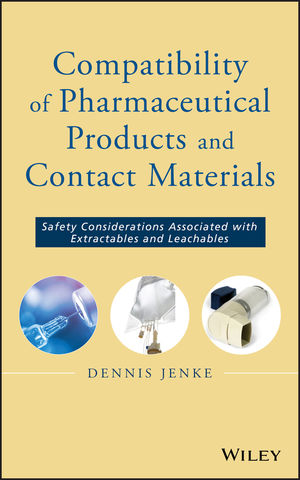Compatibility of Pharmaceutical Solutions and Contact Materials: Safety Assessments of Extractables and Leachables for Pharmaceutical ProductsISBN: 978-0-470-28176-5
Hardcover
400 pages
June 2009
 This is a Print-on-Demand title. It will be printed specifically to fill your order. Please allow an additional 10-15 days delivery time. The book is not returnable.
|
||||||
"The book provides a very detailed review of approaches for
generating and further investigating extractables and leachables
results, with advice on the levels of investigation appropriate to
each stage of product development." (BTS Newsletter, Summer
2010)
"The analogy of extractables and leachables to the bogeyman hiding in the closet is so true and telling, whether experienced with leachable studies or not the issues are well communicated. Nomenclature is established, in the author?s vernacular, which describes pharmaceutical contact materials and key terms enabling a clear understanding of the objectives of compatibility assessments. Excellent examples of extractables studies, correlations and risk assessments are given and the classification of extraction strategies puts into perspective the purpose for acquiring the data. The appendix listing materials and their associated extractables is a valuable reference tool for chemists, toxicologists and regulators involved with qualifying contact materials used with pharmaceutical products. This is a comprehensive and practical guide for both the novice and the knowledgeable. A great read!" --Diane M. Paskiet, Associate Director of Scientific Affairs, West Pharmaceutical Services
"The analogy of extractables and leachables to the bogeyman hiding in the closet is so true and telling, whether experienced with leachable studies or not the issues are well communicated. Nomenclature is established, in the author?s vernacular, which describes pharmaceutical contact materials and key terms enabling a clear understanding of the objectives of compatibility assessments. Excellent examples of extractables studies, correlations and risk assessments are given and the classification of extraction strategies puts into perspective the purpose for acquiring the data. The appendix listing materials and their associated extractables is a valuable reference tool for chemists, toxicologists and regulators involved with qualifying contact materials used with pharmaceutical products. This is a comprehensive and practical guide for both the novice and the knowledgeable. A great read!" --Diane M. Paskiet, Associate Director of Scientific Affairs, West Pharmaceutical Services



